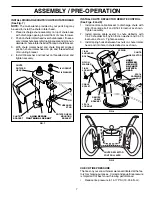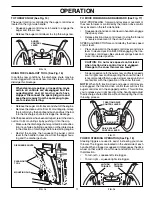
13
TO START ENGINE
• Be sure fuel shut-off valve is in the OPEN position.
Your snow thrower engine is equipped with both a 120 Volt
A.C. electric starter and a recoil starter. The electric starter
is equipped with a three-wire power cord and plug and is
designed to operate on 120 Volt A.C. household current.
• Be sure your house is a 120 Volt A.C. three-wire
ground ed system. If you are uncertain, consult a
li censed electrician.
WARNING: Do not use the electric
start er if your house is not a 120 Volt
A.C. three-wire grounded system. Se-
ri ous per son al injury or damage to your
snow thrower could result.
COLD START - ELECTRIC STARTER
1. Insert safety ignition key (packed separately in parts
bag) into ignition slot until it clicks. DO NOT turn the key.
Keep the extra safety ignition key in a safe place.
2. Place throttle control in FAST position.
3. Rotate choke control to FULL position.
4. Connect the power cord to the engine.
5. Plug the other end of the power cord into a three-hole
grounded 120 Volt A.C. receptacle.
6. Push the primer three (3) times.
7. Push starter button until engine starts.
IMPORTANT: Do not crank engine more than fi ve con-
tin u ous seconds between each time you try to start. Wait
5 to 10 seconds between each attempt.
8. When the engine starts, release the starter button and
slowly move the choke control to the “OFF” position.
9. Disconnect the power cord from the receptacle fi rst,
then from the engine.
Allow the engine to warm up for a few minutes. Engine will
not develop full power until it has reached normal operat-
ing temperature.
WARM START - ELECTRIC STARTER
Follow the steps above, keeping the choke control in the
OFF position.
COLD START - RECOIL STARTER
1. Insert safety ignition key into the ignition slot until it
clicks. DO NOT turn the key. Keep the extra safety
ignition key in a safe place.
2. Place throttle control in FAST position.
3. Rotate choke control to FULL position.
4. Push the primer four (4) times if the temperature is
below 15°F, or two (2) times if temperature is between
15° and 50°F. If temperature is above 50°F, priming is
not nec es sary.
NOTE: Over priming may cause fl ooding, preventing the
engine from starting. If you do fl ood the engine, wait a few
minutes be fore at tempt ing to start and DO NOT push the
primer.
5. Pull recoil starter handle quickly. Do not allow starter
rope to snap back.
OPERATION
6. When the engine starts, release the recoil starter
han dle and slowly move the choke control to the OFF
position.
Allow the engine to warm up for a few minutes. Engine will
not develop full power until it has reached normal operating
temperature.
WARM START - RECOIL STARTER
Follow the steps above, keeping the choke in the OFF
position. DO NOT push the primer.
BEFORE STOPPING
Run the engine for a few minutes to help dry off any mois-
ture on the engine.
To avoid possible freeze-up of the starter, proceed as fol-
lows:
ELECTRIC STARTER
1. Connect the power cord to the engine.
2. Plug the other end of the power cord into a three-hole
grounded 120 Volt A.C. receptacle.
3. While the engine is running, push starter button and
spin the starter for several seconds.
NOTE: The unusual sound made while starter is spinning
will not harm the engine or starter.
4. Disconnect the power cord from the receptacle fi rst,
then from the engine.
RECOIL STARTER
1. While the engine is running, pull the recoil starter handle
with rapid, full arm strokes three or four times.
NOTE: The unusual sound made while pulling the recoil
starter handle will not harm the engine or starter.
IF RECOIL STARTER HAS FROZEN
If the recoil starter has frozen and will not turn the engine,
proceed as follows:
1. Grasp the recoil starter handle and slowly pull as much
rope out of the starter as possible.
2. Release the recoil starter handle and let it snap back
against the starter.
If the engine still fails to start, repeat the above steps or
use the electric starter.
SNOW THROWING TIPS
• Always operate the snow thrower with the engine at
full throttle. Full throttle offers the best performance.
• Go slower in deep, freezing or heavy wet snow. Use the
drive speed control, NOT the throttle, to adjust speed.
• It is easier and more effi cient to remove snow im me -
di ate ly after it falls.
• The best time to remove snow is the early morning. At
this time the snow is usually dry and has not been ex-
posed to the direct sun and warming tem per a tures.
• Slightly overlap each successive path to ensure all
snow will be removed.
• Throw snow downwind whenever possible.
• Ad just the skid plates to proper height for current snow
con di tions. See “TO ADJUST SKID PLATES” in this
section of this manual.
Содержание 1130SBE-OV
Страница 1: ...1130SBE OV Owner s Manual ...
Страница 4: ...4 PARTS PACKED SEPARATELY IN CARTON ...














































